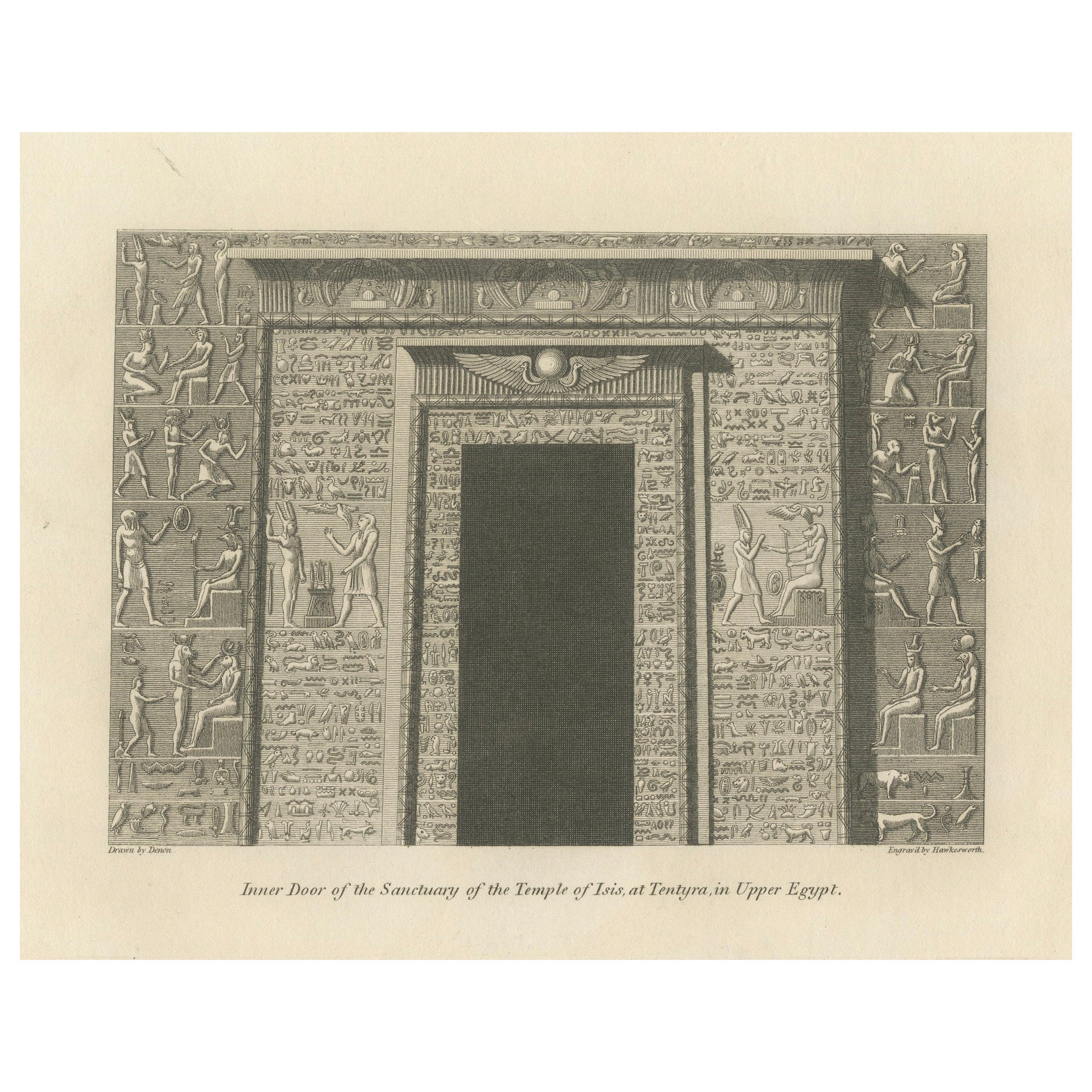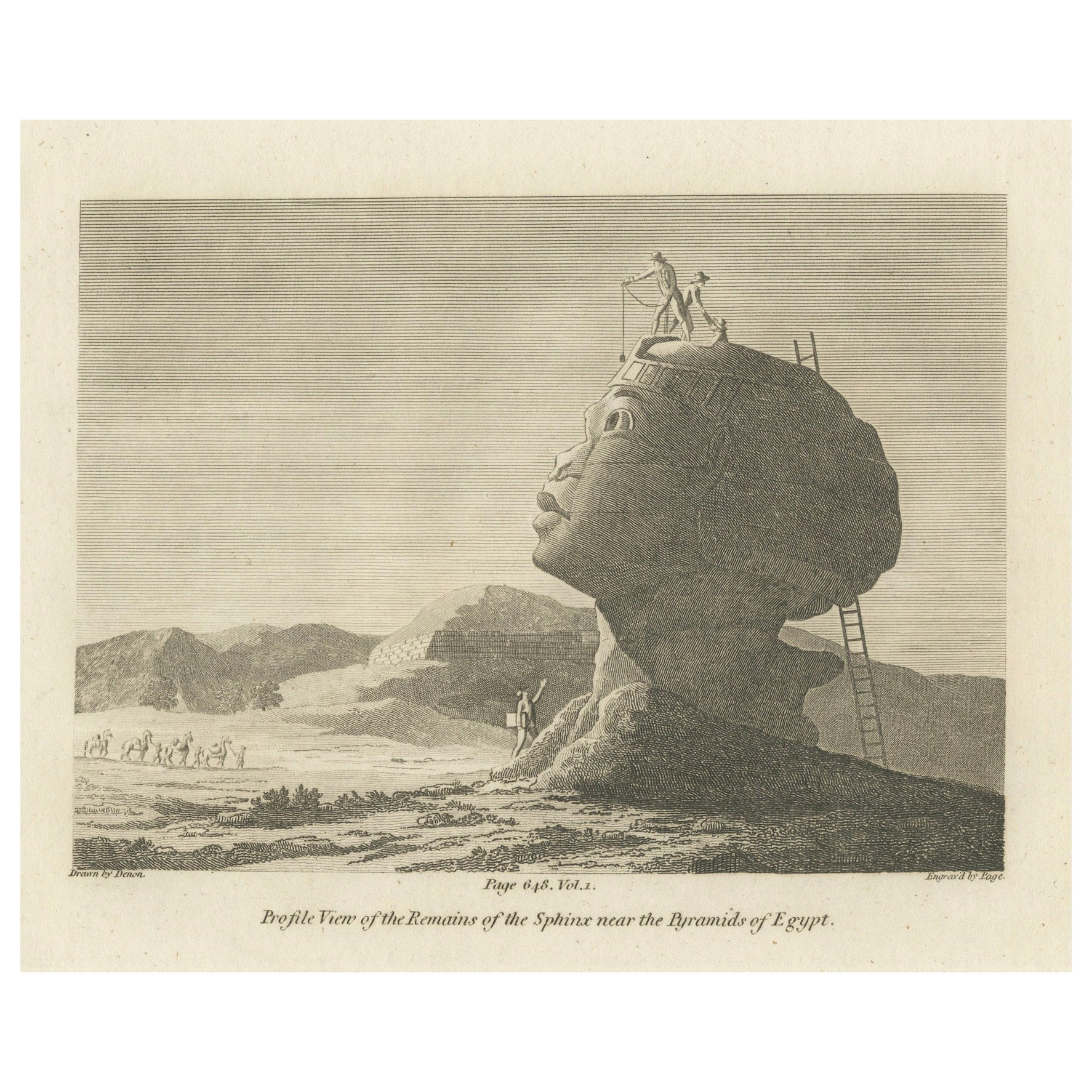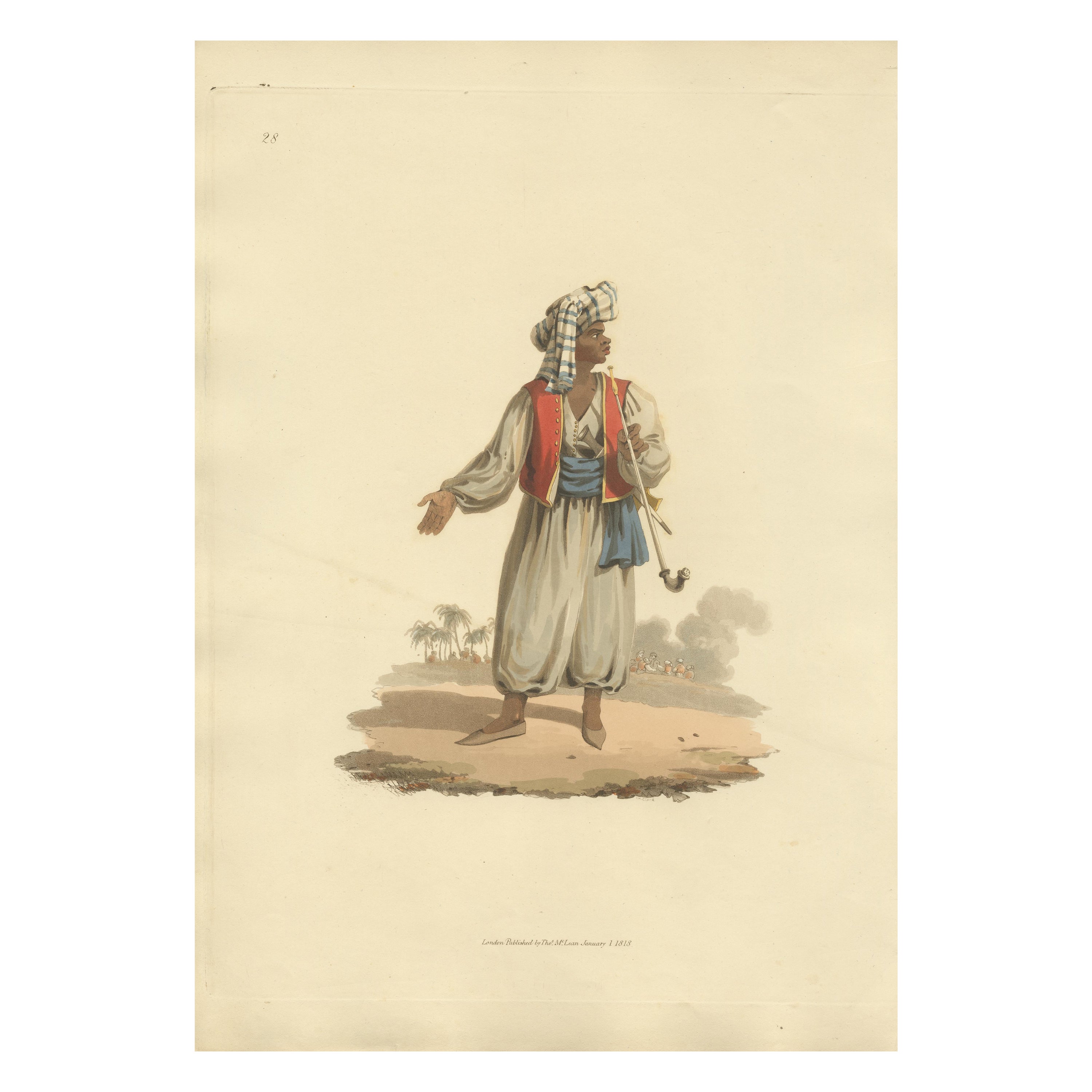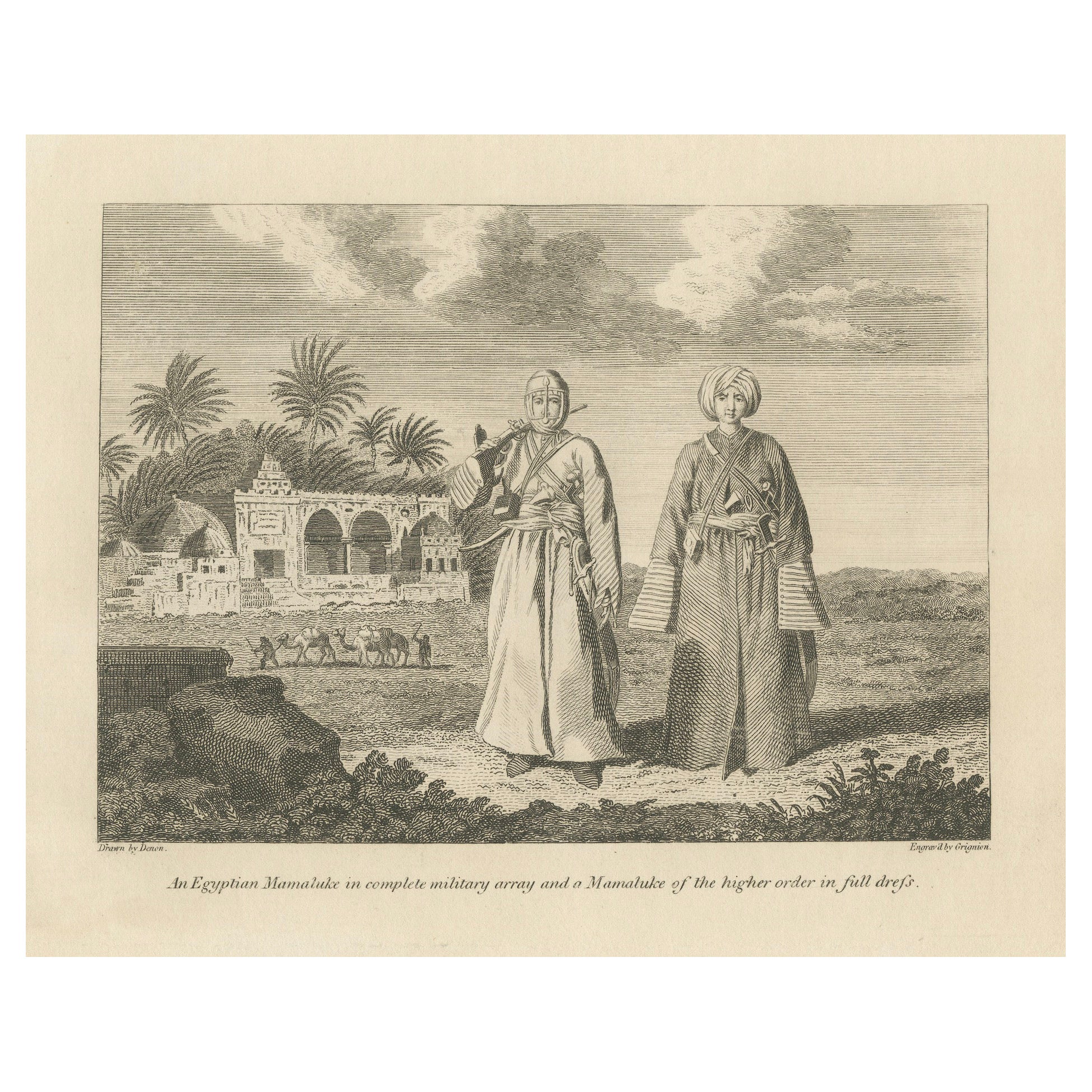Items Similar to Echoes of Thebes: The Luxor Palace Ruins in Upper Egypt, 1801
Want more images or videos?
Request additional images or videos from the seller
1 of 7
Echoes of Thebes: The Luxor Palace Ruins in Upper Egypt, 1801
About the Item
The engraving shows the majestic ruins of the Palace of Luxor, located in the village of Luxor near the site of ancient Thebes in Upper Egypt. Luxor was once a flourishing city and the pharaonic capital, known for its high social status and as a center of art, culture, and religion. The artwork captures the towering obelisks and grandeur of the remaining structures, which were part of the temple complex dedicated to the Theban triad of Amun, Mut, and Khonsu.
Description: This is a circa 1801 copperplate engraving from George Alexander Cooke's "Universal Geography" .
The print is part of George Alexander Cooke's comprehensive work "A Modern and Authentic System of Universal Geography." This book was a significant compilation of geographical knowledge during the late 18th century, offering descriptions and accounts of various parts of the world, influenced by the age of exploration. It includes narratives of famed explorers like Captain James Cook and Ferdinand Magellan, detailing their discoveries and journeys that expanded the European understanding of the globe. Cooke's work served as both a chronicle and reference for the territories and cultures encountered by these voyagers.
- Dimensions:Height: 7.88 in (20 cm)Width: 10.44 in (26.5 cm)Depth: 0 in (0.02 mm)
- Materials and Techniques:Paper,Engraved
- Period:
- Date of Manufacture:circa 1801
- Condition:Good. This is not a reproduction but an original engraving of over 200 years old. Aged paper with a slightly warm, yellowish-brown hue. Study the image carefully.
- Seller Location:Langweer, NL
- Reference Number:
About the Seller
5.0
Platinum Seller
These expertly vetted sellers are 1stDibs' most experienced sellers and are rated highest by our customers.
Established in 2009
1stDibs seller since 2017
1,922 sales on 1stDibs
Typical response time: <1 hour
- ShippingRetrieving quote...Ships From: Langweer, Netherlands
- Return PolicyA return for this item may be initiated within 14 days of delivery.
More From This SellerView All
- Threshold of Divinity: The Dendera Isis Temple Doorway in Upper Egypt, 1801Located in Langweer, NLThe engraving depicts the intricately carved inner door of the sanctuary of the Temple of Isis located in Tentyra (modern Dendera), Upper Egypt. This temple was dedicated to the godd...Category
Antique Early 1800s Prints
MaterialsPaper
- Old Engraving of the Ruins of the Palace of Cleopatra in Old Egypt, AfricaLocated in Langweer, NLThis plate shows views of the ruins of the Palace of Cleopatra, Egypt. Source unknown, to be determined. Artists and Engravers: Cornelis de Bruijn (also spelled Cornelius de Bruyn, p...Category
Antique 18th Century Prints
MaterialsPaper
- Silhouette of Antiquity: The Great Sphinx of Giza in Egypt, 1801Located in Langweer, NLThis engraving presents a profile view of the Sphinx, capturing its grandeur alongside the Pyramids of Giza in Egypt. It is a testament to the ancient ...Category
Antique Early 1800s Prints
MaterialsPaper
- Society of the Nile: Mamluk, Lady, and Almee in Egypt, 1801Located in Langweer, NLThis engraving portrays three distinct figures: an Egyptian Mamluk, an Egyptian lady, and an Almee or dancing girl, representative of Egypt's social diversity. The Mamluk stands prom...Category
Antique Early 1800s Prints
MaterialsPaper
- Antique Print of The Military Chief of Upper Egypt, 1818Located in Langweer, NLThis print is from 'The Military Costume of Turkey. Illustrated by A Series of Engravings. From Drawings made on the Spot. Dedicated by Permission to His Excellency the Minister of the Ottoman Porte to his Britannic Majesty.' London, Published by Thomas M'Lean, Haymarket, (1818). Folio. One of 29 fine handcoloured aquatint plates . Very light offsetting from plates. The original accompanying text of this print is as follows: The remote provinces of the Turkish empire pay little more than a nominal subjection to the Porte, whose commands meet with attention, in Egypt, no longer than the chiefs who govern it find their own interest concerned in obeying them. In such countries, therefore, the traveller must venture with the greatest circumspection, when the firman of the Porte is his only safeguard, which is often either doubted or held in contempt by the ignorant chief or his rapacious subalterns, whose enmity to the Christian faith is ever alive, and whose dread of magic keeps the worst suspicions awake. The firman is therefore of little use here, compared to what it is in European Turkey. The annexed subjects represents a military chief attendant on an Aga of Upper Egypt...Category
Antique 18th Century Prints
MaterialsPaper
- Mamluk Elegance: Military and Ceremonial Attire in Egypt, 1801Located in Langweer, NLThe engraving shows two Mamluks: one in full military attire, and the other, of a higher order, in full ceremonial dress. The detailed illustration captures the distinctiveness of th...Category
Antique Early 1800s Prints
MaterialsPaper
You May Also Like
- Original Antique Print of A Stag, Circa 1801Located in St Annes, LancashireGreat image of a stag Copper-plate engraving Published by Bunny and Gold . Dated 1801 Unframed.Category
Antique Early 1800s English Georgian Prints
MaterialsPaper
- "The Battle of Bunker's Hill, Near Boston" Engraving by James Mitan, 1801By John TrumbullLocated in Colorado Springs, COThis dramatic Revolutionary War engraving of the Battle of Bunker Hill is after the famous 1785 oil-on-canvas by John Trumbull. Capturing the intensity of the battle, the engraving centers on Major John Small restraining a “lobster-back” from bayoneting Major General Joseph Warren. Warren lies mortally wounded in the midst of chaos around him. In the background, British forces are seen cresting the last defenses of the brave, yet green army of Colonial soldiers. The Battle of Bunker Hill was fought on June 17, 1775, in the early stages of the American Revolutionary War. The battle is named after Bunker Hill in Charlestown, Massachusetts. Although it was the original objective of both the Colonial and British troops, the area was only peripherally involved in the battle. Rather, the majority of the combat took place on the adjacent Breed’s Hill. The battle pitted a more organized British force against a young and inexperienced American militia. Although considered a tactical victory for the British, it came at the cost of considerable casualties, including a large number of officers. The battle demonstrated that the inexperienced American militia was able to stand up to the British army troops in battle. The battle results discouraged the British from any further frontal attacks against well-defended front lines. American casualties were comparatively fewer, although their losses included Gen. Joseph Warren. During the battle, the patriot-turned-painter John Trumbull (1756-1843) was stationed in Roxbury on the far side of Boston, where he could hear the sounds of fighting. In late 1785, Trumbull decided to devote himself to the depiction of Revolutionary War scenes, a series of eight epic pictures. From the beginning, Trumbull intended for the paintings to be later engraved for sale. Trumbull began the oil-on-canvas of The Death of General Warren at the Battle of Bunker’s Hill and The Death of General Montgomery in the Attack of Quebec, in the studio of Benjamin West in London. Bunker’s Hill was completed in March 1786; Trumbull started Attack of Quebec in February 1785 and finished it before he brought it to Paris in 1786. He then started The Declaration of Independence at Thomas Jefferson's house in Paris. As soon as Bunker’s Hill was completed, Trumbull searched for a suitable engraver in London. He was unsuccessful, as many British engravers were nervous about engraving an American battle...Category
Antique Early 1800s English Federal Prints
MaterialsPaper
- J S Prout, the Upper Goulburn, Victoria', Hand Colored Engraving, U K, 1874By John Skinner Prout, N.W.S. 1Located in Chatham, ONJohn Skinner Prout (1805-1876) - 'the upper Goulburn, Victoria' - antique steel plate engraving after a painting by J. S. Prout - from 'Australia' by Edwin Carton Booth - hand colore...Category
Antique Late 19th Century British Victorian Prints
MaterialsPaint, Paper
- Set of 5 Original Antique Fishing / Angling Prints, Dated 1801Located in St Annes, LancashireGreat set of 5 fishing prints Copper-plate engravings Published by Bunney & Gold, London Unframed The measurement give below is for one print. Free shipping.Category
Antique Early 1800s English Folk Art Prints
MaterialsPaper
- Set of 12 Original Antique Sporting Prints. Dated 1801Located in St Annes, LancashireGreat set of 12 sporting prints Copper-plate engravings after the original drawings mainly by Gilpin Published by Bunney & Gold, London Unfra...Category
Antique Early 1800s English Folk Art Prints
MaterialsPaper
- Original Antique Print of The Temple of Philae, Egypt. Dated 1834Located in St Annes, LancashireWonderful image of the Temple of Philae Fine steel engraving after A.W Callcott Published by J. Murray. Dated 1834 Unframed.Category
Antique 1830s English Egyptian Revival Prints
MaterialsPaper





